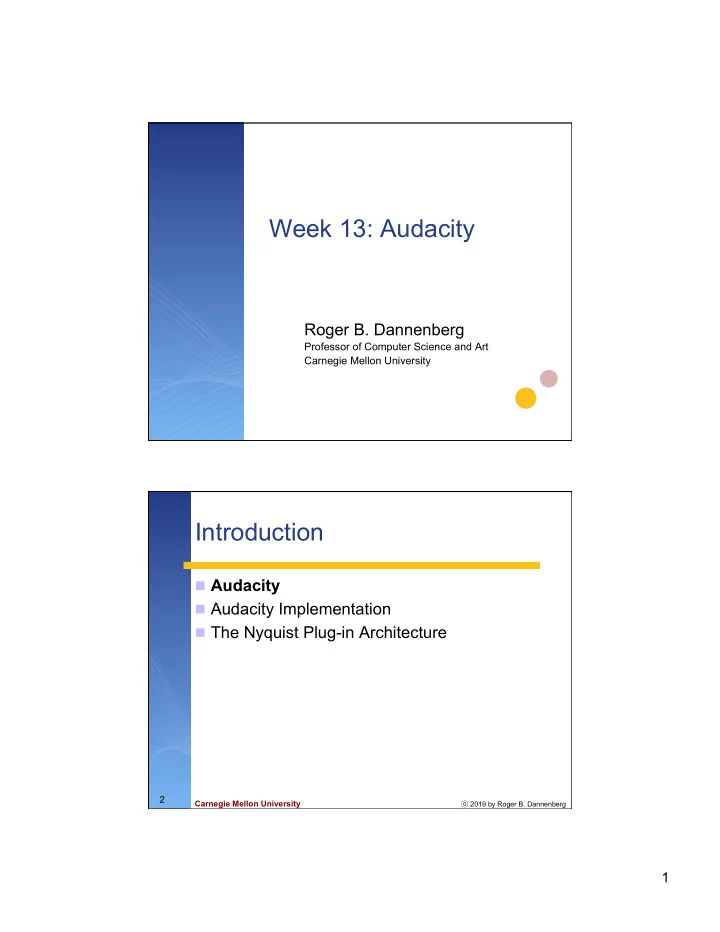

Week 13: Audacity Roger B. Dannenberg Professor of Computer Science and Art Carnegie Mellon University Introduction n Audacity n Audacity Implementation n The Nyquist Plug-in Architecture 2 Carnegie Mellon University ⓒ 2019 by Roger B. Dannenberg 1
Audacity n Graphical Audio Editor n Cross Platform: Win32, Mac, Linux n Currently for mono and stereo (but more channels possible) n Good for large files n Free and Open Source n Active development team 3 Carnegie Mellon University ⓒ 2019 by Roger B. Dannenberg Types of Audio Editors In-Place Non-Destructive n Original samples are n Original files are left alone. modified on disk. n For example: n For example: n Cubase n Adobe Audition n ProTools (CoolEdit) n Logic n Digital Performer 4 Carnegie Mellon University ⓒ 2019 by Roger B. Dannenberg 2
In-Place, Non-Destructive, and Audacity n In-Place Features: n You see results of operations n Conceptually simple: direct manipulation n Precomputes audio: no real-time problems n Non-causal, out-of-time operations possible n Non-Destructive Features: n Large files can be handled efficiently n Effect parameters can be adjusted without undoing other effects n Audacity does In-Place with efficiency. 5 Carnegie Mellon University ⓒ 2019 by Roger B. Dannenberg Introduction n Audacity n Audacity Implementation n The Nyquist Plug-in Architecture 6 Carnegie Mellon University ⓒ 2019 by Roger B. Dannenberg 3
The Sequence Data Structure Retrieve l consecutive Get( i , l ): samples from the i th sample. Set( i , l ): Change l consecutive samples from the i th sample. Insert l consecutive samples Insert( i , l ): before the i th sample. Delete( i , l ): Delete l consecutive samples from the i th sample. 7 Carnegie Mellon University ⓒ 2019 by Roger B. Dannenberg Our Sequence Implementation n For some k , split the sequence into blocks with sizes between k and 2 k . n When editing, always preserve this k -2 k property by rearranging the data within blocks. n Any Sequence operation can be performed with this restriction in only constant (disk) time. 8 Carnegie Mellon University ⓒ 2019 by Roger B. Dannenberg 4
Example: Delete( i , l ) Index in RAM 0 1 a-1 a a+1 b-1 b b+1 m-2m-1 Blocks on Disk sample i sample i + l 9 Carnegie Mellon University ⓒ 2019 by Roger B. Dannenberg Example: Delete( i , l ) Index in RAM 0 1 a-1 a a+1 b-1 b b+1 m-2m-1 sample i + l Blocks on Disk sample i 10 Carnegie Mellon University ⓒ 2019 by Roger B. Dannenberg 5
Example: Delete( i , l ) Index in RAM 0 1 a-1 a b b+1 m-2m-1 Blocks on Disk 11 Carnegie Mellon University ⓒ 2019 by Roger B. Dannenberg Advantages of a Sequence n Speed (editing operations are fast, taking constant disk time). n Easy to implement Undo by reference- counting the blocks. n With reference-counting, the same block can appear in the Sequence more than once, making duplication/loops easy to implement with low storage overhead. 12 Carnegie Mellon University ⓒ 2019 by Roger B. Dannenberg 6
Disadvantages of a Sequence n Each block is stored in a separate file. To move an audio project from one location to another, hundreds of small files must be moved. n Soon, Audacity will use SQLite, a single-file, single- process SQL database that is very efficient with large objects . E.g. Photoshop uses it for thumbnails and other data – apparently doing a query to retrieve a thumbnail image is faster than going through directories using ordinary file systems. n Using SQLite for Audacity projects, we’ll use the same sequence-of-blocks implementation, but all blocks will be in a single project file which will be an SQLite database. 13 Carnegie Mellon University ⓒ 2019 by Roger B. Dannenberg Fast Redisplay n Sample amplitudes are summarized at two zoom levels n And cached at head of blocks on disk n Simplifies implementation n Quite fast in practice n Avoids scanning actual samples n Only read data that appears on display n Discussion: would it be better to put sample amplitudes in separate files? 14 Carnegie Mellon University ⓒ 2019 by Roger B. Dannenberg 7
Performance Measurements (2001) 140 It seems that file caching is in effect up to about 100MB. Avg time per edit After that, every edit pays to read from disk, 120 but notice that this is not exponential growth. At 512MB, there seems to be an upper 100 bound or at most slow growth above 120ms. We actually ran out of disk 80 space doing measurements, so the 60 evidence for slow asymptotic growth is not rock-solid, but it matches our (ms) 40 expectation and complexity analysis. 20 0 1 2 4 8 16 32 64 128 256 512 Total File Size (MB) 15 Carnegie Mellon University ⓒ 2019 by Roger B. Dannenberg Introduction n Audacity n Audacity Implementation n The Nyquist Plug-in Architecture 16 Carnegie Mellon University ⓒ 2019 by Roger B. Dannenberg 8
Running Nyquist Within Audacity (Virtual) Sound in Audacity Unit Generators Nyquist Sound Result Sound Copy Samples (Virtual) Sound in Audacity 17 Carnegie Mellon University ⓒ 2019 by Roger B. Dannenberg 9
Recommend
More recommend